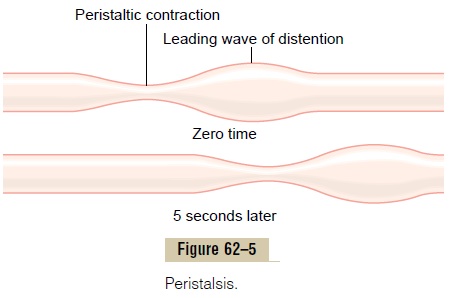Chapter: Medical Physiology: General Principles of Gastrointestinal Function- Motility, Nervous Control, and Blood Circulation
Functional Types of Movements in the Gastrointestinal Tract
Functional Types of Movements in the Gastrointestinal Tract
Two types of movements occur in the gastrointestinal tract: (1) propulsive movements, which cause food to move forward along the tract at an appropriate rate to accommodate digestion and absorption, and (2) mixing movements, which keep the intestinal contentsthoroughly mixed at all times.
Propulsive Movements-Peristalsis
The basic propulsive movement of the gastrointestinal tract is peristalsis, which is illustrated in Figure 62–5. A contractile ring appears around the gut and then moves forward; this is analogous to putting one’s fingers around a thin distended tube, then constricting the fingers and sliding them forward along the tube. Any material in front of the contractile ring is moved forward.

Peristalsis is an inherent property of many syncytial smooth muscle tubes; stimulation at any point in the gut can cause a contractile ring to appear in the circu-lar muscle, and this ring then spreads along the gut tube. (Peristalsis also occurs in the bile ducts, glandu-lar ducts, ureters, and many other smooth muscle tubes of the body.)
The usual stimulus for intestinal peristalsis is disten-tion of the gut. That is, if a large amount of food col-lects at any point in the gut, the stretching of the gut wall stimulates the enteric nervous system to contract the gut wall 2 to 3 centimeters behind this point, and a contractile ring appears that initiates a peristaltic movement. Other stimuli that can initiate peristalsis include chemical or physical irritation of the epithelial lining in the gut. Also, strong parasympathetic nervous signals to the gut will elicit strong peristalsis.
Function of the Myenteric Plexus in Peristalsis. Peristalsisoccurs only weakly or not at all in any portion of the gastrointestinal tract that has congenital absence of the myenteric plexus. Also, it is greatly depressed or completely blocked in the entire gut when a person is treated with atropine to paralyze the cholinergic nerve endings of the myenteric plexus. Therefore,effectual peristalsis requires an active myenteric plexus.
Directional Movement of Peristaltic Waves Toward the Anus.
Peristalsis, theoretically, can occur in either direction from a stimulated point, but it normally dies out rapidly in the orad direction while continuing for a considerable distance toward the anus.The exact cause of this directional transmission of peristalsis has never been ascertained, although it probably results mainly from the fact that the myenteric plexus itself is “polar-ized” in the anal direction, which can be explained as follows.
Peristaltic Reflex and the “Law of the Gut.” When asegment of the intestinal tract is excited by distention and thereby initiates peristalsis, the contractile ring causing the peristalsis normally begins on the orad side of the distended segment and moves toward the dis-tended segment, pushing the intestinal contents in the anal direction for 5 to 10 centimeters before dying out. At the same time, the gut sometimes relaxes several centimeters downstream toward the anus, which is called “receptive relaxation,” thus allowing the food to be propelled more easily anally than orad.
This complex pattern does not occur in the absence of the myenteric plexus. Therefore, the complex is called the myenteric reflex or the peristaltic reflex. The peristaltic reflex plus the anal direction of movement of the peristalsis is called the “law of the gut.”
Mixing Movements
Mixing movements differ in different parts of the ali-mentary tract. In some areas, the peristaltic contrac-tions themselves cause most of the mixing.
This is especially true when forward progression of the intes-tinal contents is blocked by a sphincter, so that a peristaltic wave can then only churn the intestinal con-tents, rather than propelling them forward. At other times, local intermittent constrictive contractions occur every few centimeters in the gut wall. These constric-tions usually last only 5 to 30 seconds; then new con-strictions occur at other points in the gut, thus “chopping” and “shearing” the contents first here and then there. These peristaltic and constrictive move-ments are modified in different parts of the gastroin-testinal tract for proper propulsion and mixing.
Related Topics